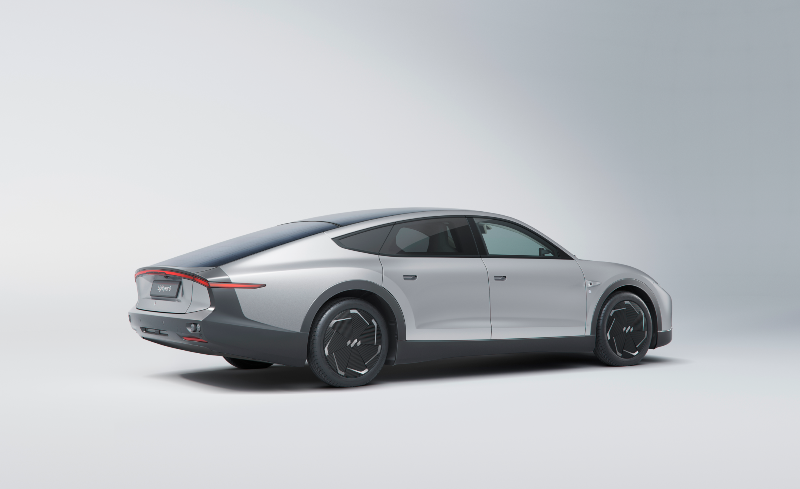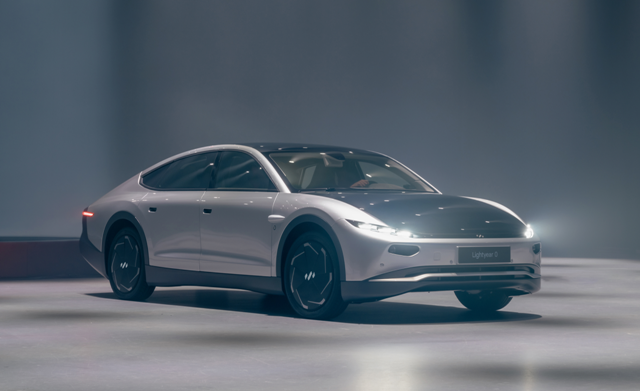Lightyear 0 charges itself whenever the roof absorbs daylight. Charging becomes a journey, not a destination.
Over the past few years, several startups have released one-off solar-powered concept vehicles, but up until now, we have yet to receive a mass-produced solar-powered car. It looks like that will change soon with the introduction of the Lightyear 0—an electric sedan that gets its power from the sun.
Lightyear is a Dutch startup that has an ambitious goal to start production of the Lightyear 0 this fall with the first deliveries starting in November. The Lightyear 0 features 5 square meters of double-curved solar arrays that can charge the electric vehicle while it’s driving or parked outdoors. The solar panels can add up to 43 miles (70 kilometers) of range a day in addition to its estimated 388 miles (625 kilometers) on Europe’s WLTP cycle.
This means drivers can literally drive for months without having to use an outlet or public charger. Lightyear estimates people who drive an average daily commute of about 22 miles, could go up to seven months between charges. Lightyear estimates the solar panels can add up to 6,835 miles (11,000 kilometers) of range per year.
Lightyear 0 Solar EV: The Most Aerodynamic Production Car On Earth
Holland’s Lightyear has just sent its first vehicle, the 0, into the wind tunnel and the results are impressive. The electric vehicle has a drag coefficient of just 0.175, making it the most aerodynamic production vehicle on earth.
The figure was confirmed in the FKFS wind tunnels in Stuttgart, Germany, under Worldwide Harmonized Light Vehicle Test Procedure (WLTP) conditions. The results are particularly impressive when compared to other vehicles.
A Jeep JL Wrangler, for example, has a drag coefficient of 0.454, which, despite its boxy shape really isn’t all that bad, considering that a 1996 Dodge Viper RT has a Cd of 0.45. Delving into the realm of more modern sporty cars, the Lexus LFA (with its wing retracted) has a Cd of 0.31.
To be fair, though, sporty cars aren’t always as aerodynamic as we might imagine, because of the downforce they try to generate. Even more modern EVs struggle to get below a Cd of 0.2, though, with the original Tesla Model S reaching 0.24, the Model 3 0.23, the Lucid Air 0.21, and the Mercedes EQS reaching 0.20. In fact, the Lightyear 0 is very nearly as aerodynamic as the Mercedes EQXX concept car, which has a Cd of 0.170.
As that car proved, reducing drag is extremely important for increasing the efficiency of electric vehicles, whose range often suffers over long stretches of highway driving. As Lightyear puts it, keeping drag low, while keeping lift force in check, is a very important and difficult balance to strike.
“We are extremely proud of this incredible achievement,” said Arjo van der Ham, the automaker’s chief technology officer. “We had to start from a blank sheet of paper when we started developing our technology and – with a lot of dedication and hard work – we continue to push the boundaries with every milestone like this.”
All that efficiency and solar power don’t come cheap, though. The Lightyear 0, which goes into production in two months, will start at a price of €250,000 ($249,731 USD at current exchange rates).
To Infinity and Beyond
Beyond the dozens of new and exciting car models and futuristic tech, the growth of electric vehicle development and sales has created an opportunity for new automakers to join the market. In the U.S., there’s Rivian and Lucid, and in Europe there’s a new company named Lightyear making waves. The Dutch startup’s first car is called the Lightyear 0, and it sports one of the most striking designs seen today.
Once you’re past the visual impact of the car, the innovative details start popping up in droves. Most notably, the Lightyear 0’s body is covered in solar panels. They provide legitimate range benefits and look pretty cool in the process.
The Lightyear 0 is extremely expensive, at $250,000, and will be produced in limited quantities. That means we’re unlikely to see many (or any) on our roads here in the United States, but Lightyear has plans for a cheaper and more available model down the road.
Here’s what you need to know about the Lightyear 0.
What Is Lightyear 0?
The Lightyear 0 is an electric car with five square meters of solar panels that cover its trunk lid, roof, and hood. The sedan operates like a normal electric vehicle otherwise, with a charging port, electric motors and batteries.
Other vehicles have offered solar charging in the past, but the Lightyear’s recovery powers dwarfs previous efforts. Depending on where in the world the car spends its days, it could add as much as 44 miles of range per day from the solar panels alone. Total driving range extends to 388 miles, though, so there’s plenty of mileage even on cloudy days.
Lightyear extensively uses recycled and sustainably sourced materials throughout the car. Reclaimed carbon fiber forms its body panels, and the company uses vegan and naturally sourced materials for the interior.
Performance and Electric Powertrain of Lightyear 0
The Lightyear 0 looks sporty and sleek, but its spec sheet shows that it’s tuned far more for efficiency and range than speed. The car features a 10-second 0-62 mph (0-100km/h) time, not sluggish but also nowhere near the figures other modern EVs put down. It’s also limited to a top speed of around 99 mph (160 km/h).
At the same time, the car delivers solid range, fast charging capabilities, and the solar recovery party trick. With a full battery, there’s 388 miles on tap, placing the Lightyear 0 in the top tiers of EV range rankings. The Tesla Model 3 Long Range AWD is rated at 358 miles and the Model S Long Range is rated at 405 miles, so the upstart Lightyear 0 is a strong first effort.
Lightyear 0 Charging and Range
Lightyear promises fast charging speeds for the car. Using a standard household outlet, Lightyear 0 recovers 20 miles of range per hour. Public chargers increase that to 124 miles per hour and DC fast charging returns a whopping 323 miles of range per hour.
The car’s defining feature is its solar panel array, which covers five square meters of its exterior. Up to 44 miles of range can be added via the panels per day, but the rate is highly dependent on climate. Lightyear’s most optimistic range estimations are based on locations in the Mediterranean, where the sun is a regular and prominent fixture of everyday life. People living in cooler, cloudier climates won’t see as much benefit, but Lightyear still estimates that the panels will deliver between 3,700 and 6,800 miles of free electric range per year.
Additional Performance of Lightyear 0
Four in-wheel motors provide propulsion for the Lightyear 0. Combined power output lands at around 170 horsepower. Lightyear designed the powertrain and surrounding thermal management systems to capture and reuse residual heat, which the company says helps keep components at their ideal temperature while minimizing energy loss.
Though it’s not a crossover, the Lightyear 0 features 7.2 inches of ground clearance, which combines with all-wheel drive to give the car a reasonable level of light off-road capability. The intention is for the car to be useful in as wide a variety of situations as possible, not for it to moonlight as a rock-crawling off-road rig.
Lightyear 0 Design
The Lightyear 0 is around 200 inches long, 78 inches wide, and 57 inches tall. That makes it two inches longer and one inch taller than a Tesla Model S. The car features four doors, a unique lift-back trunk, and partially covered rear wheels.

Pic Credits: Lightyear One
While many automakers try to avoid the super-futuristic spaceship look with new EVs, Lightyear has fully embraced the motif. The Lightyear 0 looks like it rolled right out of a starship’s cargo bay, with an immense glass roof and sweeping rear profile. The shape clearly came together in a wind tunnel, and the resulting aerodynamics are impressive. The car has a drag coefficient of less than 0.19, which is better than the Lucid Air and Porsche Taycan, two of the most slippery EVs on sale today.
Lightyear 0 Interior
The Lightyear 0’s interior is minimalist but high-tech, and offers impressive styling. The automaker notes seating for five people, and says there’s up to 22.6 cubic feet (640 liters) of space in the trunk. That’s a little shy of the 25 cubic feet offered by the Tesla Model S but almost twice the figure offered by the Porsche Taycan.
Interior finishes are composed of vegan and naturally-sourced materials, including responsibly sourced palm trees and synthetic suede. The expansive solar panels on the car’s exterior mean there’s no room for a sunroof, but the interior space appears light and airy, thanks to large windows and light colored upholstery and trim. Heated front seats come standard.
Technology of Lightyear 0
The Lightyear 0 comes with a 10.1-inch touchscreen running Android Auto OS. Despite the fact that it’s a Google-powered interface, the system supports Apple CarPlay, and Lightyear offers an app that allows drivers to interact with the car’s locks, climate, and other features. Navigation, Bluetooth, and over-the-air updates are also standard.
The car comes standard with a fully configurable digital gauge cluster, though Lightyear hasn’t elaborated on its size. Beyond audio and entertainment, the touchscreen system provides vehicle information, such as state of charge, solar energy charging rate, and range.
Lightyear Car Range
That low coefficient of drag, combined with the Lightyear 0’s solar panels, contribute to its extraordinary range. The company estimates that the car will have a WLTP range of 388 miles (625 km). In optimal conditions, though, it says that the car could recoup up to 43 miles (70 km) of range per day thanks to the sun.
That means, Lightyear says, that the in a bright place, in circumstances where the car is mainly being used for the average European commute, the 0 could go for months before it needs to be plugged into a charger.
Lightyear 0 Safety and Warranty
The Lightyear 0 hasn’t been crash tested by any European or North American evaluation agencies, but the car comes well equipped with driver aids from the factory. Standard tech includes a 5-inch side-view camera system, a 7-inch continuous rearview camera system, parking sensors, speed limit recognition, rain-sensing wipers, adaptive cruise control, and more.
Lightyear includes an anti-theft alarm system and backs the car with an 8-year bumper-to-bumper warranty.
Pricing, Availability and Competition of Lightyear 0
Lightyear Car Price
The Lightyear 0 is on sale now with a starting price of around $250,000 at today’s exchange rate with the Euro. Lightyear will only build 946 of the cars, however, so they are in exceedingly short supply.
Lightyear Car Release Date
Following the Lightyear 0, the automaker will build a higher-volume, lower-price solar electric vehicle. Expected to start at around $30,000, the car should make an appearance by early 2025.
Competitor of Lightyear 0
The Lightyear 0’s most direct competitor is the Lucid Air, mainly due to the two cars’ six-figure price points. The Lucid Air sports a longer range of up to 520 miles, but lacks solar charging capability. That said, the Lucid is shockingly quick, and could leave the Lightyear 0 in its dust.

Pingback: BMW XM 2023: What We Know So Far - Best Electric Vehicle
Pingback: Electric Planes are The Future of Aircraft 2026 - Best Electric Vehicle